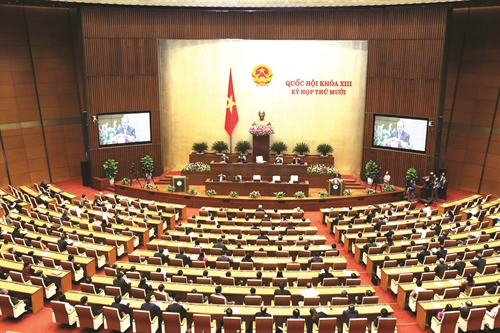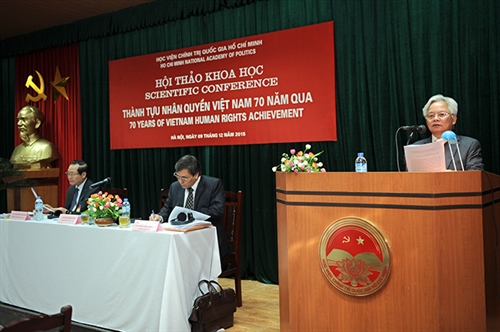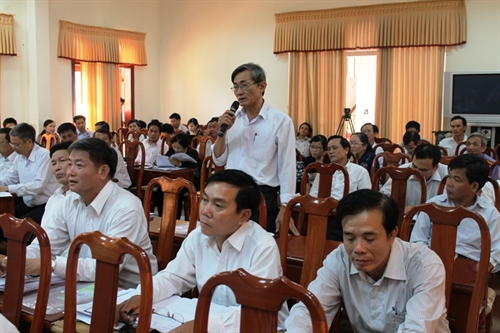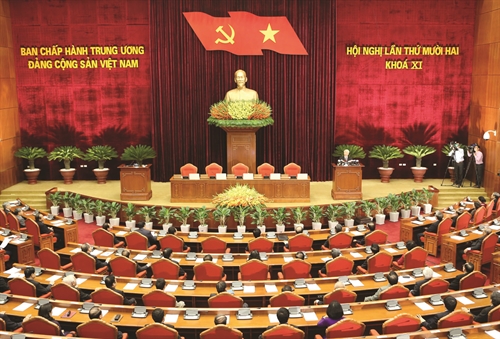Nguyen Van Thang, Bach Ngoc Thang and Do Thanh Huyen[1]
Introduction
Experiences from developed countries have shown that transparency, accountability and participation significantly reduce corruption, which in turn helps increase access to and improve the quality of public services. When it comes to developing countries, the links between governance, corruption and public service quality are under debate due to the prevalence of corrupt practices in public services and challenges in combating corruption in the public sector.
In Vietnam, corruption has been formally and openly recognized by top leaders as a key obstacle for the country to prosper. However, it is also commonly but arguably perceived that, under a complex public sector and malfunctioning formal institutions like those in Vietnam, corruption may help “greasing the wheels”, thus promoting efficiency of public services, because it creates incentives for public employees to earn their living from serving the state and its people. Efforts to promote transparency, accountability and participation to reduce corruption and improve public service quality in Vietnam have been embarked on over the past two decades as the national agenda on public administration reforms has been implemented. However, there is slow pace of progress in anti-corruption in public service delivery in Vietnam (see Malesky, Edmund, 2015, and CECODES, VFF-CRT & UNDP, 2015, for instance)[2].
This article looks into how corruption affects public service delivery, and whether or not good governance practices like enhanced transparency, accountability and citizen participation can help reduce corruption in Vietnam.[3] It addresses two specific questions: (i) to what extent does corruption affect quality of healthcare and primary education?, and (ii) how do citizen participation, transparency and accountability help reduce corruption? Survey data from the Vietnam Provincial Governance and Public Administration Performance Index (PAPI) from 2011 to 2014 were used to answer the questions. Findings and policy implications in this article are expected to provide relevant authorities with information about and evidence of how good governance practices can help reduce corruption in public services and improve service quality. It is of particular relevance as Vietnam is revisiting anti-corruption strategies and measures in 2016, amidst a new office term for the Vietnam Communist Party, the Government of Vietnam and the National Assembly from 2016-2021.
Corruption and the quality of public service delivery
This section addresses the question of whether or not corruption affects public serve delivery. This is possible because both data on corruption and public service delivery are available in the PAPI data. Specifically, in PAPI, citizens are asked if they encountered corrupt practices when using public health care at district hospitals and primary education at public primary schools available at the commune level. They are also asked about the quality of the two services by specific experiential criteria.
The first issue to look at is whether or not corruption affects the quality of public healthcare and primary education. Corruption in these two sectors is widely recognized in Vietnam, and low wages for healthcare workers and teachers and decreasing public investment in the sectors are to blame. It is commonly perceived that, without additional informal incomes and under-the-table incentives, healthcare staff and teachers would not feel motivated to be attentive to patients and students, and that the sectors would not be able to attract high quality personnel. In other words, bribes and corruption may have helped beef up the quality of the two services.
Such reasoning for the unhealthy practices is going against what is expected from the public sectors in delivering public services in terms of moral and ethical values as commonly assigned to the sectors. Bribery for better care at public hospitals and primary schools would only benefit those who can afford it and exclude a large majority of the population from access to quality services. Thus, any observable positive impact that bribes can create is short-termed and transactional while the damage corruption causes is system-wise and long-term.
Using the panel-data from 207 districts across 63 provinces in Vietnam, we find that corruption vigorously reduces the quality of healthcare and primary education. First, let us look into bribery in the healthcare sector. Figure 1 provides the interplay between citizens’ corruption perception and their assessment of the quality of healthcare services received in 2011-2014. In this figure, every single dot represents a combination of the corruption level on the horizontal axis and the corresponding quality of healthcare on the vertical axis. The higher the level of corruption is, the lower the quality of health care will become, as indicated by the downward-sloping regression line (fitted values) in Figure 1. The negative correlation is persistent across the four years of the PAPI data (2011-2014), and it seems to intensify in 2012 and 2013, as evidenced by steeper slopes of the regression lines in these two years. This provides strong evidence that corruption negatively affects the quality of healthcare, at least at the district level. (See Figure 1)
 |
| Figure 1: Corruption and the quality of healthcare in 2011-2014 |
Similarly, corruption decreases the quality of primary education. Our analysis using PAPI data from 2011-2014 shows a negative association between corruption and the quality of primary education. Figure 2 summarizes this negative association, as evidenced by the downward-sloping regression line (fitted values). In this regard, the higher the corruption is the lower the quality of primary education would become, as perceived by citizens.
However, the magnitude of the effect is smaller in the primary education sector as compared to that in the healthcare sector. There are two reasons for this smaller effect. First, the level of corruption in the primary education is generally lower than that in the healthcare sector across the four years of PAPI surveys. Second, public primary education is universal and free for all children. This second feature plays a role in offsetting somewhat the negative effect of corruption on the quality of public healthcare. Some may argue that this negative effect does not hold in regions with better socio-economic conditions and better infrastructure, like urban areas or provinces with high growth rates. However, further statistical tests (e.g., the fixed-effect regression, which is able to control for disparity in these initial conditions across provinces) indicate that corruption consistently has a negative association with education quality. (See Figure 2)
 |
| Figure 2: Corruption and the quality of primary education in 2011-2014 |
Good governance and corruption
The PAPI data has shown that corruption negatively affects the quality of some basic public delivery like health care and primary education. This adds more pressure on the fight against corruption in the public sector. Controlling corruption is important not only for good functioning of the State, but also for better delivery of basic public services. But how could we control corruption in the public sector? Conventional approach to anti-corruption is to enhance good governance practices, i.e. to promote transparency, accountability and participation, which are expected to lower officials’ discretion, enhance supervision from multi-stakeholders, and clarify responsibilities and payoffs from irregular practices. These are the keys to prevent and deter corruption.
It should be noted that promoting transparency, accountability and participation in developing countries like Vietnam faces a number of challenges. First, political corruption is seen as common in developing countries. Many politicians owe their careers and statuses to corruption, and a few of them, if any, would stand against it after being appointed. For this type of corruption, transparency, accountability and participation will not work since these politicians are the ones who decide how much of such good governance practices to be applied. Second, the lack of the rule of laws, sound and strong law enforcement, capable public officials and sufficient resources is the key hindrance to realizing all those panaceas. Finally, the ignorance and silence of corruption victims, maintained by a culture of fears being nurtured by those who benefit from corruption, is another impediment to fighting corruption.
Table 1 summarizes a number of key trends in practicing transparency, accountability and participation in Vietnam as indicated in the PAPI data from 2011-2014. It indicates that the level of the overall corruption perception increased persistently in this period, from 1.7 in 2011 to 2.0 in 2014. Citizen participation seems to decrease sharply overtime, as the percentage of people having direct, not proxy, voting in village head elections reduced from 72% in 2011 to 67% in 2014. In another aspect of citizen participation, citizens were less eager in reporting corrupt behaviors. The level of unwillingness to report corruption raised persistently from 3.3 in 2011 to 4.3 in 2014. With respect to transparency, the percentage of citizens saying that the commune budget and expenditure were disclosed increased from 64% in 2011 to 72% in 2014. However, this upward trend seemed to retard in the more recent years from 2012-2014. Finally, the accountability mechanism through the People’s Inspection Boards was enhanced slightly during the period from 2011-2014. The percentage of citizens saying that the People’s Inspection Boards were effective increased from 52% in 2011 to 58% in 2014. Local governments are getting more serious in dealing with corruption cases, reflected in increasing number of respondents saying that their local governments were serious about anti-corruption from 54% to 57% in the same period. (See Table 1)
Table 1: Overall corruption perception and some governance attributes
| Variables | 2011 | 2012 | 2013 | 2014 |
| Overall corruption perception a | 1.7 | 1.8 | 1.9 | 2.0 |
| Citizen participation | ||||
| Voting in local elections | 72% | 73% | 71% | 67% |
| Unwillingness to report corruption b | 3.3 | 3.4 | 4.1 | 4.3 |
| Transparency | ||||
| Commune budget and expenditure disclosure | 64% | 70% | 71% | 72% |
| Accountability | ||||
| Effectiveness of People’s Inspection Boards | 52% | 55% | 57% | 58% |
| Seriousness of local governments in dealing with corruption cases | 54% | 53% | 55% | 57% |
| Notes: Figures are in percentage, except otherwise indicated. a The additive individuals’ perception of corruption in six specific measures of diversion of state budget, bribes for land titles, bribes for health care, bribes for primary education, bribes for construction permit, and bribes for state employment. b The higher the value is the more people are unwilling to report corrupt behaviors. | ||||
Table 1 presents an overall picture of how citizens assess transparency, accountability and participation at the local level from 2011-2014. It shows that such good governance practices have not yet been embraced by both the governments and citizens. But, do these good practices help reduce corruption?
Our regression results indicate that promoting transparency, accountability and participation does help reduce corruption. In particular, disclosing commune budget and expenditure information and taking it serious in dealing with corruption cases by local authorities have the largest effects. The former reduces corruption as it helps decrease public servants’ discretion in state budget uses and enhance multi-stakeholders’ supervision of public budget and expenditure. The latter result indicates that the success of anti-corruption efforts in Vietnam largely relies on the wishes and wills of political leaders. Direct voting in local elections, effectiveness of People’s Inspection Boards, willingness to report corruption all help reduce corruption, although they differ slightly in the magnitude of the effect. Citizens’ willingness to report corrupt behaviors is another issue as citizens became less eager overtime from 2011-2014. This poses a real challenge, as the fight against corruption cannot work without citizen participation in the cause.
Conclusions and policy recommendations
The article has presented results from our study to empirically examine whether or not citizen participation, transparency and accountability are associated with less corruption, and whether lower levels of corruption relate to better public service quality. Our results show that persistent corruption is associated with low quality education and healthcare services. While bribes may provide incentives for better services, these effects are largely short-termed, transaction-specific, and only applied to those who can afford to bribe. The long-term losses of innovation, commitment, and morality of service delivery staff are much more damaging. Where corruption is prevalent, public service delivery personnel pay attention to getting bribes or informal payments from citizens and are distracted from improving quality of service. Worse still, state resources designated to public service delivery may be drained by corrupt officials by the time they reach the end-users. This damage is especially serious in places where commitment, morality and innovation are very fragile in the public sector.
This article offers several recommendations for consideration in government policy making to promote citizen participation, transparency and accountability to better control corruption in the public sector. First, active citizen participation in reporting corruption in public services is critical. With a more rights-based constitutional foundation set forth in the 2013 Constitution, together with the support of new technology and social media, there is light of hopes for greater genuine citizen participation for better governance in Vietnam in the years to come.
Second, genuine participation is hard to obtain in anti-corruption agendas when citizens are not encouraged to report against any wrong doings by public officials and when they feel they are not protected taking anti-corruption initiatives. As our research has shown, citizens’ willingness to report corrupt practices decreased in the period from 2011-2014. Promoting the roles of media and civil society to be the intermediary platforms for citizens to report on corruption will help central and local governments to prevent corruption. Upcoming revisions to the Law on Anti-corruption should spell this out more profoundly so as to improve the effectiveness of anti-corruption work.
Third, citizen participation and the accountability mechanism like People’s Inspection Boards would be meaningless if transparency is not respected. In the last decade, the need for more transparency and information disclosure has been well recognized. However, the relevance (i.e. the level of details and disaggregation of data) and quality (i.e. the reliability and timeliness) of information needs to be improved. In an essence, disclosure of budget and expenditure information helps reduce corruption at local levels while more access to other types of government information would be necessary to enhance anti-corruption effectiveness. It is timely for a Law on Access to Information that facilitates rather than policing access to information to be promulgated. The law will serve as a legal framework to foster transparency and engage citizens and institutions in calling central and local governments into account and keeping public service delivery agencies under check to better control corruption.
Forth, accountability to citizens and non-state actors need to be fostered among public officials and civil servants. As the research and UNDP, CECDES and VFF (2014) have pointed out, it is important to improve the effectiveness of the People’s Inspection Boards, the grassroots monitoring mechanisms by citizens to keep the performance of public officials and civil servants under check. By giving PIBs an enlarging space, necessary skills and easy-to-follow toolkits, these boards will exercise their mandates and power as promulgated in the Ordinance on Grassroots Democracy and the Law on Inspection. In order for PIBs to be effective, citizen participation in selection of their members is a must.
Last but not the least, fostering good governance means that the government needs to gain a considerable trust from the public. To this end, there should be a fundamental shift in the mindset and attitude of public officials and public employees. Providing good information to the public, inviting the public to participate in policy agenda, and responding accountably to the public concerns are good mechanisms to gain trust and fight corruption.-









